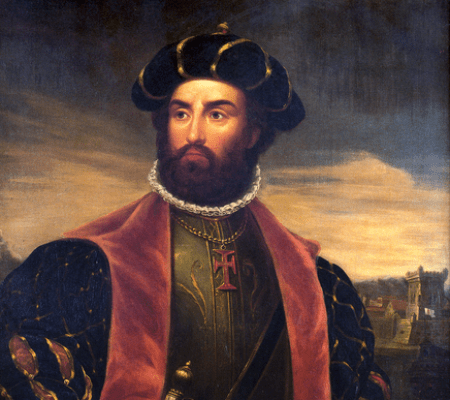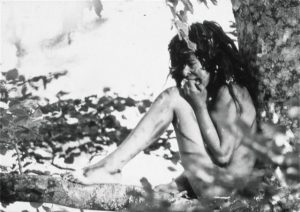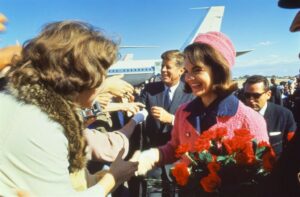Vasco da Gama, the first European to sail around the continent of Africa to Asia, was born into a noble Portuguese family around 1460 in Sines, Portugal. He was the third son of Esevao da Gama, also a navigator, that was the commander of the fortress of Sines on the coast of Alentejo. He joined the Portugal navy as soon as he was old enough to join. Under the direction of King John II, da Gama was appointed commander of a ship with the intention of finding a sailing route to India. In 1492, King John II sent da Gama to a port south of Lisbon, known as Setubal, and to Algarve to seize French ships in retaliation to the French destroying Portugal shipping.1
In 1487, on a voyage funded by Portugal, Bartholomeu Dias found that the Indian and Atlantic Oceans were linked and discovered a passage around the Cape of Good Hope. When King Manuel rose to power in 1495, he decided to revisit the possibility that Dias’s new route opened the potential to sending a Portuguese fleet to Asia around Africa. He wanted to open a route for Portugal to make money trading spice and thereby establish Portugal as a major maritime and colonial power. A few years later, in 1497, da Gama was appointed to command a ship by King Manuel. Although da Gama was an inexperienced explorer, he was appointed to lead the expedition to discover a sailing route to India.2
For the expedition, da Gama turned to Dias to help him plan and organize the trip. His fleet consisted of two new ships that were built specifically for the expedition and two refurbished ships that were equipped with better cannons than the new ones. He recruited a crew of 170 men that included some of Portugal’s most experienced navigators. Along with the experienced navigators, he looked for men that were tough enough to withstand the harsh conditions of life at sea. Many of the crew that he recruited were convicts whose lives, he believed, were expendable.3

On July 8, 1497, da Gama set sail from Lisbon to Asia. He was accompanied by Dias who served as pilot to the Canary Islands. The fleet reached the Canary Islands on July 15 and proceeded on to the Cape Verde Islands. After spending the next days at Cape Verde resting and preparing for the next stage of their trip, the crew set sail again on August 3; Da Gama and his crew would not see land for the next three months. On November 22, he led his crew around the Cape of Good Hope, and on Christmas Day, arrived at what is known today as Natal. The expedition made several stops along the eastern coast of Africa to trade the goods in their possession for fruits and vegetables. On March 2, 1497, Da Gama and his crew arrived at what is known as Mozambique; they stationed themselves there for several months to allow the crew time to recover from the scurvy they had contracted and to repair their vessels. With the help of a local Muslin pilot, he then departed across the Indian Ocean and reached Calicut on May 20.4 Although the King of Calicut was staying at Ponnani, he returned to Calicut upon hearing of the foreigners’ arrival. Da Gama was initially received with the usual hospitality, and he traded goods with their host, but sadly their goods were not appreciated. The goods that da Gama and his crew brought did not sell. In addition to their goods not selling well, the Muslin merchants, with whom da Gama had conflicts and who dominated the city’s trade, convinced the zamorin that they would gain nothing by entering into a trade agreement with the intruders.5
Despite not having secured a trade agreement, he was able to secure a large shipment of spices before leaving. On his return voyage back to Portugal, da Gama encountered extensive hardship. The return voyage claimed the life of his brother Paulo, who had captained one of the ships, as well as the lives of many of his crew. On his arrival back to Lisbon, on September 9, 1499, da Gama received wealth and titles.6
On February 12, 1502, da Gama set sail again; he traveled to India with twenty warships with the intention of implementing Portuguese interests. His second voyage was that of a military expedition that was commissioned by the King of Portugal to demonstrate Portuguese power. On his second voyage, he encountered conflicts with Arab merchants. He assaulted and demanded praise from the Arab-controlled port of Kilwa. He also used threats and violence against the local rulers to force them to submit to the Portuguese authority. On his return to Portugal, he was made Count of Vidigueira, and was awarded feudal rights and jurisdiction over Vidigueria and Vila dos Frades. Having the recognition as someone who could “fix” problems that arose in India, he embarked on his third and final voyage in 1524. Portugal now had forts and settlements in India, and da Gama was sent to replace the inadequate Eduardo de Menezes as viceroy of the Portuguese properties. However, soon after arriving da Gama contracted malaria and died.
Da Gama’s expeditions were extremely valuable to the Portuguese. His voyages opened maritime trade between Asia and Europe. Prior to Vasco da Gama’s voyages, Portugal was comparatively a poor resource country. It relied on trade to help it become a strong country. Da Gama’s voyages also impacted the Portuguese economy by bringing back spices to Portugal, opening the spice trade to Portuguese merchants. The spice trade was very lucrative and helped make Portugal one of the most important trade and naval powers in the Indian Ocean. Finally, the voyages opened a direct route from Asia to Portugal, which had a huge impact considering that travel prior to the voyages was very dangerous.
- Encyclopedia Britannica, January 14 2016, s.v. “Vasco da Gama,” by Felipe Fernandez-Armesto. ↵
- Encyclopedia Britannica, January 14 2016, s.v. “Vasco da Gama” by Felipe Fernandez-Armesto. ↵
- Jennifer Stock, “Vasco da Gama Sails to India,” Global Events: Milestone Events Throughout History, vol. 4 (2014): 162-164. ↵
- Jay Kinsbruner, “Gama, Vasco da (1524),” Encyclopedia of Latin American History and Culture, vol. 3 (2008): 366-367. ↵
- Peter N. Stearns, “Gama, Vasco da (ca. 1460–1524),” Encyclopedia of European Social History, vol.6 (2001): 115-116. ↵
- Neil Schlager, “Vasco da Gama,” Science and Its Times, vol. 3 (2001): 84-85. ↵



17 comments
Mark Martinez
A well written and put together article. It seems kind of sad how even after all his accomplishments and trials de Gama just got sick and died. He clearly had a passion for the ocean since he joined the navy the first chance he had, and made a career out of it. Vasco de Gama did what was almost impossible at the time and created a new trade route between two continents.
Aaiyanna Johnson
I had never of Vasco de Gama before, but I glad that I now have. It surprised me that he was an amateur of navigating yet he did so well. He was also smart. By getting convicts they had no value to him, nor society. It must have been hard for him to lose his brother, and then have his last voyage without his brother by his side.
Gabriela Serrato
Yet another article that provided information that is all new to me. I was not aware of the impact that Portugal had made throughout the world. They not only expanded their own horizons, but became aware of new things such as different spices. It is important to be aware of your surroundings and even this type of trade was important as is exposed people to new things. Without the spread of goods across the world, this country alone would not even have the knowledge of so many things.
Eduardo Foster
Nice article! The information presented is amazing! We can say that Vasco Da Gama vas definitely a master at sailing. Its encouraging to see how much he help his country by founding a route! He managed to help Portugal build into an empire and settle good deals with Indian communities. Also it’s fascinating how he managed to found a route like about 700 years ago!
Oceane Roux
It is incredible that men such as Da Gama went on expeditions for their country. They abandoned their families for a long period of time and left on ships in hope to find a way to get to another country with the possibility of getting lost and contracting diseases. I imagine that they didn’t have an unlimited amount of food and water, and even if they stayed close to the land, I find it very risky. Because of them, Portugal has been able to develop its economy and we have a better understanding of our world. Eventually, in my view, it is important to realize how long it had taken them to draw our actual world map.
Faisal Alqarni
Hello, Aaron, this article was very helpful as it provided a lot of information about Vasco da Gama. As one of the famous from the age of discovery, it’s actually fascinating to know that his discovery of the route to India around Africa actually allowed the Portuguese to build empire in Asia. I think he is remembered for his determination that saw him rich India successful by sea when other explorers found it impossible.
Mario De Leon
This was a great article that had a lot of information. It is clear that Vasco de Gama was born to be at sea and it was no surprising that he was the first to sail around Africa to Asia. I find it interesting that most of the crew that he recruited were mostly convicts or people who had little significance to society.